1. Yoo JH. The forever war against evil germs. J Korean Med Sci. 2023; 38(10):e72. PMID:
36918026.

2. World Health Organization. Global Action Plan on Antimicrobial Resistance. Geneva, Switzerland: World Health Organization;2015.
3. Kim K, Jung S, Kim M, Park S, Yang HJ, Lee E. Global trends in the proportion of macrolide-resistant
Mycoplasma pneumonia infections: a systemic review and meta-analysis. JAMA Netw Open. 2022; 5(7):e2220949. PMID:
35816304.
4. van Aerde KJ, de Haan L, van Leur M, Gerrits GP, Schers H, Moll HA, et al. Respiratory tract infection management and antibiotic prescription in children: a unique study comparing three levels of healthcare in the Netherlands. Pediatr Infect Dis J. 2021; 40(3):e100–e105. PMID:
33395212.

5. Mathibe LJ, Zwane NP. Unnecessary antimicrobial prescribing for upper respiratory tract infections in children in Pietermaritzburg, South Africa. Afr Health Sci. 2020; 20(3):1133–1142. PMID:
33402958.

6. Weragama K, Mudgil P, Whitehall J. Pediatric antimicrobial stewardship for respiratory infections in the emergency settings: a systematic review. Antibiotics (Basel). 2021; 10(11):1366. PMID:
34827304.

7. Romandini A, Pani A, Schenardi PA, Pattarino GA, De Giacomo C, Scaglione F. Antibiotic resistance in pediatric infections: global emerging threats, predicting the near future. Antibiotics (Basel). 2021; 10(4):393. PMID:
33917430.

8. Bjornson CL, Johnson DW. Croup. Lancet. 2008; 371(9609):329–339. PMID:
18295000.

9. Ryu S. The new Korean action plan for containment of antimicrobial resistance. J Glob Antimicrob Resist. 2017; 8:70–73. PMID:
28024981.

10. Cheong HS, Park KH, Kim HB, Kim SW, Kim B, Moon C, et al. Core elements for implementing antimicrobial stewardship programs in Korean general hospitals. Infect Chemother. 2022; 54(4):637–673. PMID:
36596679.

11. Hwang S, Kwon KT. Core elements for successful implementation of antimicrobial stewardship programs. Infect Chemother. 2021; 53(3):421–435. PMID:
34623776.

14. Perez A, Lively JY, Curns A, Weinberg GA, Halasa NB, Staat MA, et al. Respiratory virus surveillance among children with acute respiratory illnesses – new vaccine surveillance network, United States, 2016–2021. MMWR Morb Mortal Wkly Rep. 2022; 71(40):1253–1259. PMID:
36201373.

15. Jeon IS, Cho WJ, Lee J, Kim HM. Epidemiology and clinical severity of hospitalized children with viral croup. Pediatr Infect Vaccine. 2018; 25(1):8–16.

16. Song YK, Han N, Kim MG, Chang HJ, Sohn HS, Ji E, et al. A national pharmacoepidemiological study of antibiotic use in Korean paediatric outpatients. Arch Dis Child. 2017; 102(7):660–666. PMID:
28119402.

17. Sun G, Manzanares K, Foley KA, Zhou Y, MacGeorge EL. Antibiotic stewardship with upper respiratory tract infection patients at student health centers: Providers’ communication experiences and strategies. Am J Infect Control. 2023; 51(2):154–158. PMID:
35605753.

18. Korea Disease Control and Prevention Agency. Report of Infection Control and Prevention in Medical Facilities in 2021. Cheongju, Korea: Korea Disease Control and Prevention Agency;2016.
19. Breuner CC, Moreno MA. Approaches to the difficult patient/parent encounter. Pediatrics. 2011; 127(1):163–169. PMID:
21173004.

20. Lee S. Spatial and socioeconomic inequalities in accessibility to healthcare services in South Korea. Healthcare (Basel). 2022; 10(10):2049. PMID:
36292496.

21. Cho BH. Regional Inequalities in Healthcare Workers and Medical Facilities.: Korean Social Trends 2018. Daejeon, Korea: Korea Statistics Research Institute;2018. p. 100–110.
23. Korea Disease Control and Prevention Agency. Guidelines for the Antibiotics Use in Children With Acute Upper Respiratory Tract Infection. Cheongju, Korea: Korea Disease Control and Prevention Agency;2016.
24. Shin SM, Shin JY, Kim MH, Lee SH, Choi S, Park BJ. Prevalence of antibiotic use for pediatric acute upper respiratory tract infections in Korea. J Korean Med Sci. 2015; 30(5):617–624. PMID:
25931794.

25. Watson JR, Wang L, Klima J, Moore-Clingenpeel M, Gleeson S, Kelleher K, et al. Healthcare claims data: an underutilized tool for pediatric outpatient antimicrobial stewardship. Clin Infect Dis. 2017; 64(11):1479–1485. PMID:
28329388.

26. Korppi M, Heikkilä P, Palmu S, Huhtala H, Csonka P. Antibiotic prescribing for children with upper respiratory tract infection: a Finnish nationwide 7-year observational study. Eur J Pediatr. 2022; 181(8):2981–2990. PMID:
35606593.

27. Rybak MJ, McGrath BJ. Combination antimicrobial therapy for bacterial infections. Guidelines for the clinician. Drugs. 1996; 52(3):390–405. PMID:
8875129.

28. Hong KB, Choi EH, Lee HJ, Lee SY, Cho EY, Choi JH, et al. Macrolide resistance of Mycoplasma pneumoniae, South Korea, 2000–2011. Emerg Infect Dis. 2013; 19(8):1281–1284. PMID:
23876792.
29. Kim JH, Kim JY, Yoo CH, Seo WH, Yoo Y, Song DJ, et al. Macrolide resistance and its impact on
M. Pneumonia pneumonia in children: comparison of two recent epidemics in Korea. Allergy Asthma Immunol Res. 2017; 9(4):340–346. PMID:
28497921.

30. Park JY, Kang HM, Kwak EM, Rhim JW, Ahn YH, Lee H, et al. Impact of antibiotic prescribing patterns on susceptibilities of uropathogen in children below 24 months old. Antibiotics (Basel). 2020; 9(12):915. PMID:
33339282.

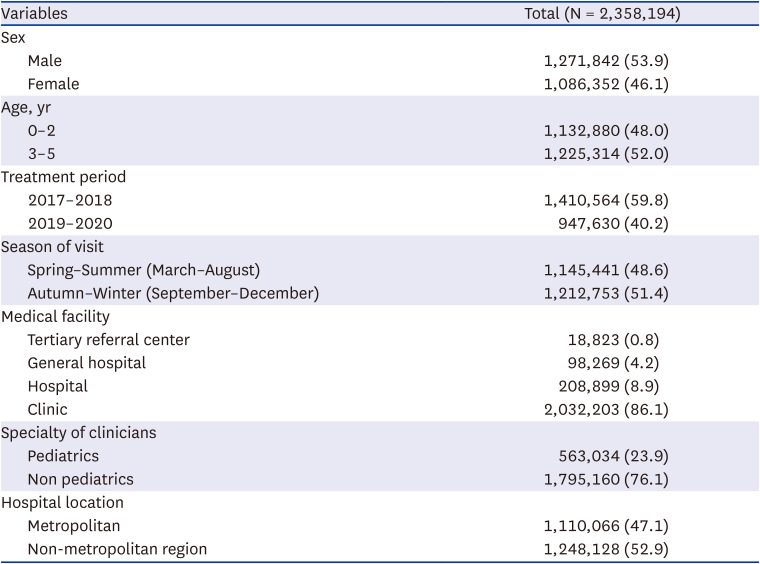
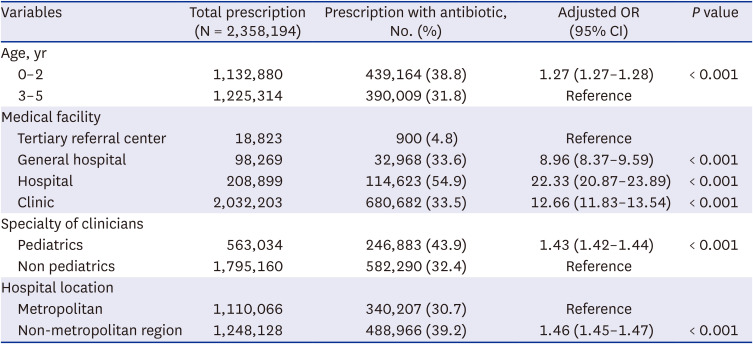

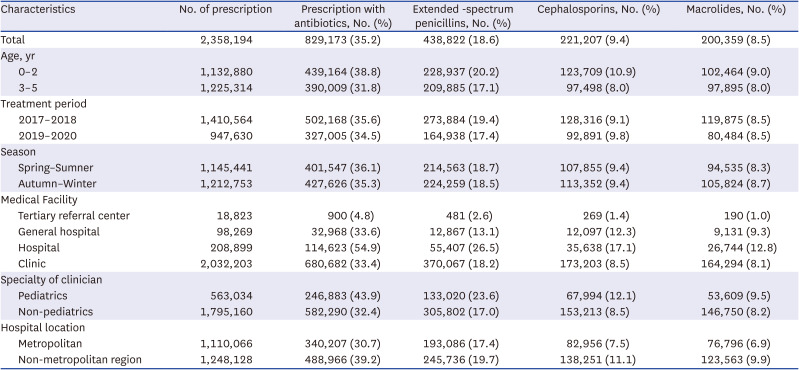




 PDF
PDF Citation
Citation Print
Print



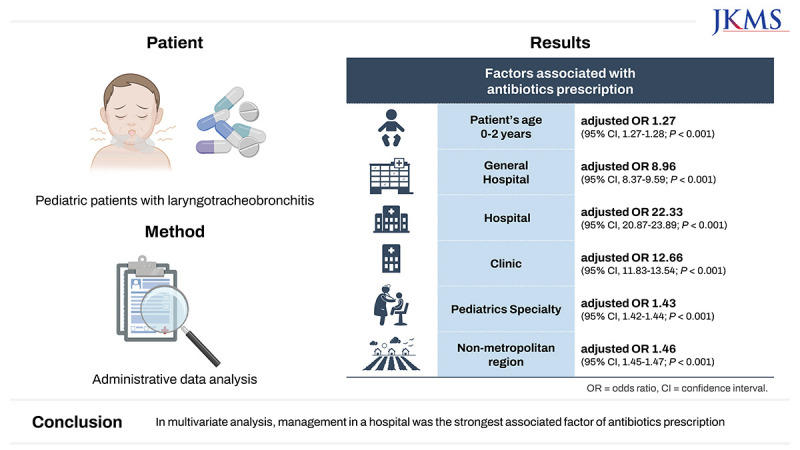
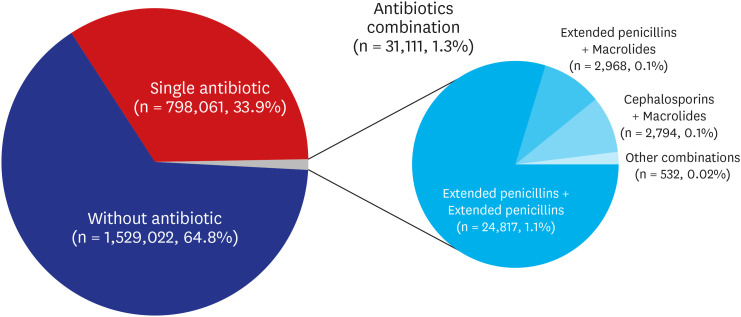
 XML Download
XML Download